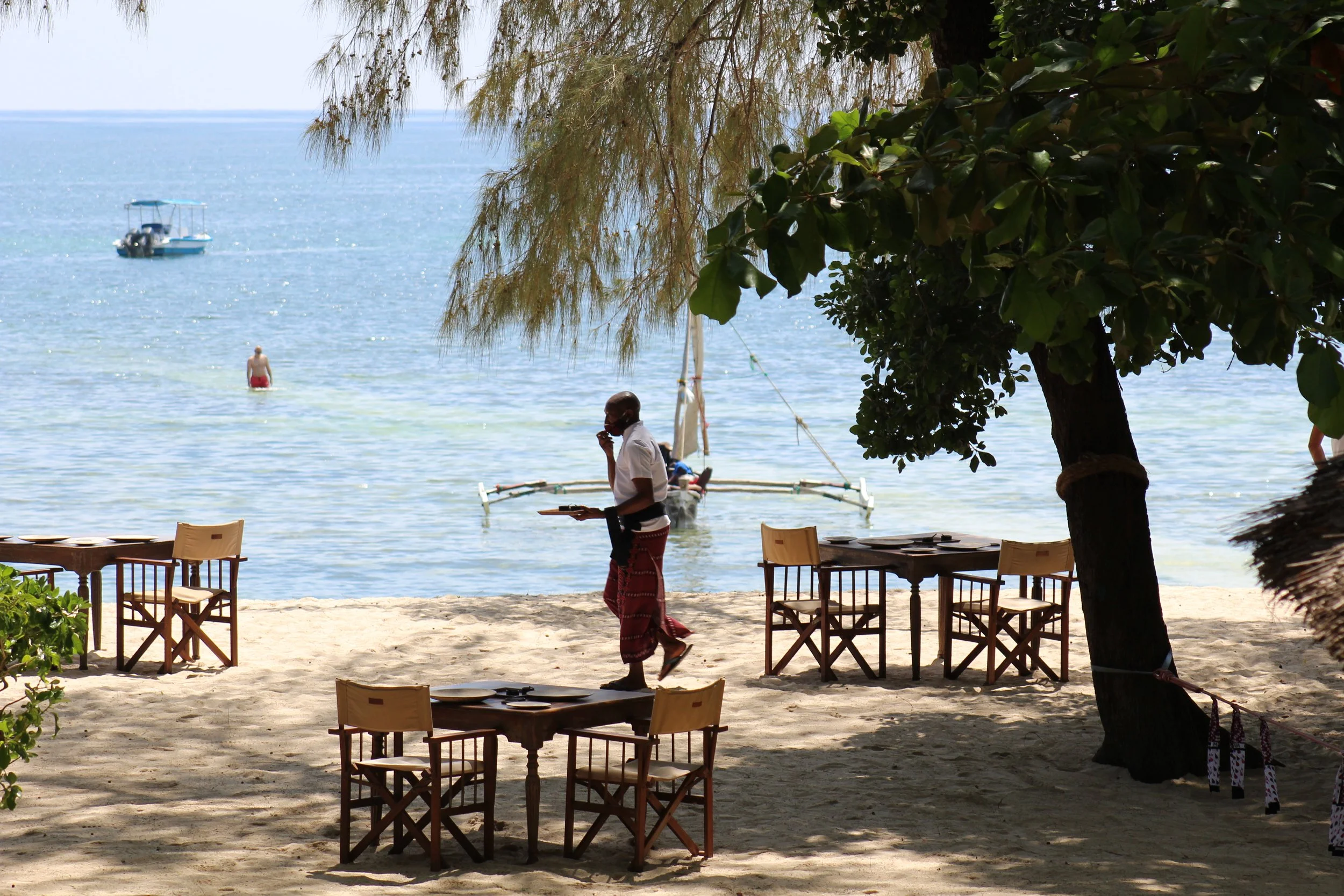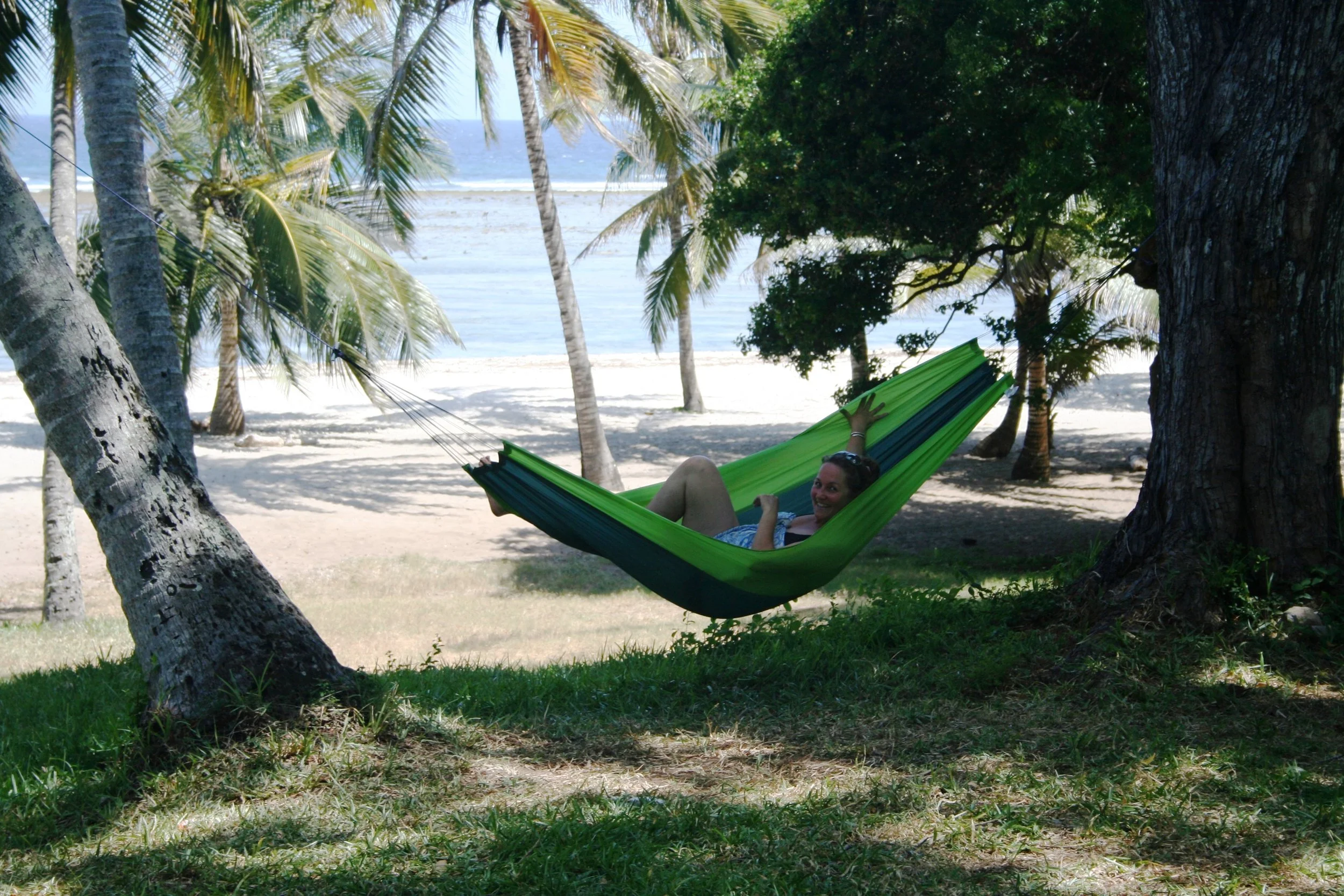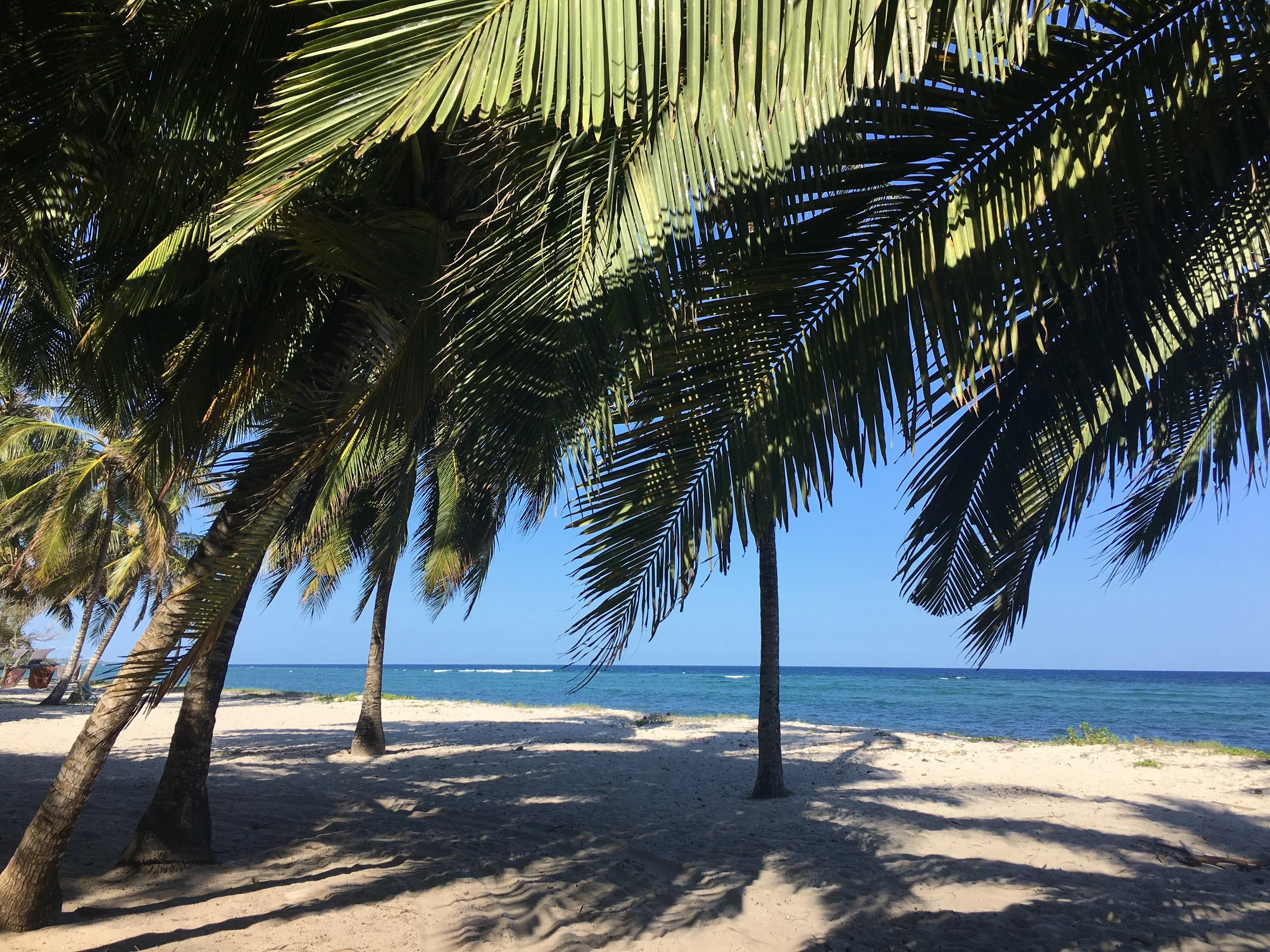Kenya's Best Beaches: My Honest Guide from Diani to Lamu
Why Kenya's Coast Deserves Your Attention
Kenya's 500-kilometre Indian Ocean coastline consistently surprises people. Pristine white beaches, fascinating Swahili culture, and luxury resorts that genuinely rival the Maldives – all without the marathon flight times or brutal jet lag.
From Europe, you're looking at roughly eight hours flying and just two or three hours' time difference. Compare that to 12+ hours to the Caribbean or Maldives, and you start to see the appeal of not spending your first two days in a jet-lagged haze.
The coast works brilliantly as a safari extension – the transition from early game drives to lazing on pristine beaches is easy and stress free. But it's equally excellent as a standalone beach destination, particularly if you've done the safari thing before and just want sun, sea, and excellent food without the complications of ultra-long-haul travel.
📸: Dining under the palms at Kinondo Kwetu
When to Visit: Getting the Timing Right
Understanding Kenya's coastal seasons makes all the difference to your holiday.
Peak season (January–mid-February): Hot, dry, and crystal clear. This is textbook tropical perfection with temperatures in the low 30s and calm seas ideal for diving and snorkelling. You'll pay peak prices, but conditions are superb. Late February often sees the rains starting to arrive.
High season (July–September): Cooler but still lovely, with temperatures in the high 20s. This coincides with prime safari season inland, making it perfect for combinations. The slightly cooler weather actually suits many Europeans better than the January heat.
Shoulder seasons (October–November, early December): Excellent weather with more moderate pricing. October and November deliver great conditions without the crowds, whilst December sees beautiful weather return after the short rains – though Christmas itself commands premium rates.
Low season (late February–May): The "long rains" typically start in late February and run through May, significantly disrupting beach plans. Whilst this creates brilliant safari conditions inland with lush vegetation and fewer tourists, I generally don't recommend it for beach extensions unless you're particularly flexible about activities.
The Indian Ocean stays invitingly warm year-round, ranging from 25°C in August to 29°C in April. Diving and snorkelling conditions peak from October to March when underwater visibility can exceed 30 metres.
Diani Beach: One of Africa's Finest
Diani consistently wins awards for Africa's best beach, and having visited repeatedly, I'd argue it deserves them. This 25-kilometre stretch of powder-white sand backed by coconut palms delivers exactly what you imagine when you picture a tropical paradise – except it's real, and it's spectacular.
The sand is so fine it literally squeaks underfoot, the water shifts through impossible shades of turquoise, and offshore reefs create calm lagoon conditions perfect for swimming whilst providing excellent snorkelling just beyond. It's the kind of place where even after a week, you still catch yourself thinking "this is absurdly beautiful."
Why Diani Works So Well
The beauty is consistent along the entire beach – you're not fighting for one "good" stretch. This means accommodation choice comes down to style and budget rather than location anxiety. And there's proper choice here, from intimate boutique hotels to comprehensive resorts, all maintaining standards that safari travellers expect.
The adventure options complement the relaxation nicely. Kite surfing benefits from reliable trade winds, the diving is excellent (October–April particularly), and the offshore fishing rivals anywhere in the Indian Ocean. But crucially, you never feel pressured to do activities – pure beach time works perfectly well.
Shimba Hills National Reserve sits just inland, offering forest walks and elephant viewing if you want to maintain that safari connection. And there's a decent championship golf course at Leisure Lodge for those who can't leave the clubs at home.
Whale Sharks and Marine Life
From October to April, whale sharks migrate through these waters. Swimming alongside the world's largest fish ranks among the coast's most memorable experiences – a rather different kind of wildlife encounter from tracking elephants inland.
Where to Stay in Diani
Alfajiri Villas represents the absolute pinnacle – three exclusive villas with private beaches, infinity pools, and dedicated staff including butlers and chefs. The cliff-top and garden settings offer different perspectives, but all deliver that "private paradise" feeling. Perfect for honeymoons or when you want complete exclusivity.
Kinondo Kwetu takes a family-owned approach to luxury. Five cottages, three suites, and garden rooms create an intimate atmosphere where staff genuinely know you. It's luxury without the formality – the kind of place where you feel like a houseguest rather than a hotel client. It’s very boho chic, you’ll want to make sure you’ve got plenty of white linen to wear.
Almanara Villas offers six private villas, each with butler, chef, and host. It's almost cruise-ship levels of attention, but in a beachfront villa setting. Brilliant for groups or families wanting flexibility with hotel-level service.
Waterlovers Beach Resort embraces eco-conscious principles whilst maintaining modern amenities and comfort, demonstrating that sustainability needn't mean compromising on quality. With just eight suites, a villa, and a fantastic penthouse which is perfect for families, this intimate property combines Swahili culture with Mediterranean style. Consistently ranked amongst Diani's top properties, it offers the perfect blend of barefoot luxury and personalised attention.
Nomad Beach Resort embraces boutique luxury with intimate scale ensuring proper personalised service. Contemporary design creates sophisticated beach house aesthetics, and the beachfront position means you're on that famous sand in seconds.
📸: Waterlovers Beach Resort has a perfect location above Diani Beach
Getting to Diani
Ukunda Airstrip sits just ten minutes from most resorts, with regular flights from Nairobi and major safari regions. You can genuinely be on safari in the morning and swimming in the Indian Ocean by afternoon.
The road route via Mombasa and the Likoni Ferry takes about 90 minutes but offers scenic coastal views and that memorable ferry crossing. Worth considering if you're not rushed.
📸: Me enjoying some quality hammock time on Diani Beach back in 2008
Watamu: Where Marine Life Takes Centre Stage
Watamu consistently ranks among Kenya's finest beaches, and its reputation as a marine paradise is thoroughly deserved. Part of a UNESCO Biosphere Reserve, the marine park here delivers world-class diving and snorkelling that genuinely rivals anywhere in East Africa.
The destination has developed a bit of an "Little Italy of Africa" character thanks to Italian settlement dating back decades, resulting in sophisticated dining and gelaterias that actually rival Milan. But don't let that put you off – it maintains authentic coastal character whilst offering excellent European-standard cuisine.
The Marine Experience
Watamu Marine National Park protects flourishing coral reefs that support exceptional biodiversity. You'll encounter turtles, rays, and countless tropical fish species in underwater landscapes as dramatic as any savannah vista. The protected status means the reefs have genuinely thrived rather than suffering the degradation you see in many tourist destinations.
Turtle Bay Beach itself offers pristine white sand and calm waters, with the beach's gentle slope making it particularly suitable for families. The name reflects its importance for sea turtle nesting, and several conservation organisations work here protecting these ancient mariners.
Mida Creek presents a completely different environment – extensive mangrove ecosystems offering exceptional birdwatching and kayaking. Sunset kayaking through the mangroves ranks among Watamu's most memorable experiences, showing coastal ecology distinct from both beach and reef environments.
Deep-sea fishing from Watamu has achieved legendary status, particularly for sailfish and marlin from September to March. Several specialised operators run sport fishing charters with experienced captains who know these waters intimately.
Where to Stay in Watamu
Medina Palms has established itself as Kenya's most luxurious coastal resort. Swahili-style architecture encompasses spacious residences providing more room than conventional hotels, whilst multiple restaurants showcase exceptional cuisine. The spa delivers treatments using local ingredients, and the beachfront position means the marine park sits immediately offshore. For discerning safari travellers seeking the ultimate coastal conclusion, this is it.
Hemingways Watamu carries the reputation of its Nairobi namesake, delivering renowned service in a prime beachfront setting and is one of the few larger resorts that I’d recommend on the coast. Strong sport fishing heritage means excellent boats and experienced crews, whilst the beachfront pool and spa facilities suit those preferring more relaxed pursuits.
Getting to Watamu
Direct flights connect to Nairobi and major safari hubs. The nearby Malindi airport serves both Watamu and Malindi, with transfers to Watamu properties taking about 30 minutes.
Lamu: UNESCO Heritage Meets Indian Ocean
Lamu stands apart as one of East Africa's most authentic cultural experiences. This UNESCO World Heritage island delivers something completely different from conventional beach resorts – a place where centuries-old Swahili culture meets pristine coastline, and where donkeys and traditional dhows provide the only transport because cars simply aren't allowed.
The contrast to typical safari-then-beach holidays is profound. Here, the pace slows right down and cultural immersion takes priority over resort activities. It's not for everyone – if you want comprehensive spa facilities and multiple restaurants, look elsewhere. But if you're intrigued by authentic Swahili architecture, bustling markets, and that sense of stepping back in time, Lamu is extraordinary.
Why Lamu Matters
The architecture tells centuries of stories – Swahili, Arab, and Portuguese influences visible in maze-like alleys winding between tall coral stone walls. Traditional carved doors showcase intricate craftsmanship that has defined Lamu for generations. You're not visiting a museum; you're walking through a living, breathing community where traditions continue much as they have for centuries.
The dhow sailing experience connects you tangibly to maritime trading history. These graceful vessels with their distinctive triangular sails provide both your arrival and ongoing exploration, physically connecting you to centuries of Indian Ocean seafaring tradition.
Shela Beach stretches for miles beyond the main town, offering unspoiled white sand that remains remarkably uncrowded even during peak season. The peaceful island atmosphere provides perfect counterpoint to safari excitement, allowing genuine rest in surroundings of considerable historical significance.
When to Visit Lamu
Optimal months run from July to October and January to mid-February, aligning perfectly with premium safari seasons. Late February through May should generally be avoided as rains can disrupt the dhow sailing that forms such an integral part of the experience.
Peak season runs in December through mid-February, when cultural festivals add extra vibrancy, though advance booking becomes essential for better properties.
Where to Stay in Lamu
Peponi Hotel holds legendary status as Shela's premier beachfront property. Intimate scale suits post-safari relaxation perfectly, with the famous Fisherman's Bar serving sundowners to generations of travellers. Rooms reflect Arab heritage whilst providing contemporary comfort, and you wake to Indian Ocean views and fall asleep to wave sounds.
The Majlis Resort offers more contemporary luxury with spectacular views across to Lamu Island from its elevated position. Two pools provide options, whilst spa facilities prove ideal for recovering from safari adventures. Meticulous design shows attention to detail safari travellers appreciate.
Manda Bay represents boutique lodge experience on Manda Island's northern tip – a secluded palm-fringed peninsula that feels wonderfully remote. Cottages nestle within indigenous forest steps from deserted beaches, whilst coral gardens offshore provide exceptional snorkelling. Romantic and unspoilt, perfect for genuine seclusion. My clients report that they love it here!
For something genuinely different, consider the traditional dhows NaiSabah and Tusitiri. These beautifully restored sailing vessels offer multi-day adventures through the archipelago, combining the romance of traditional dhow travel with surprisingly comfortable accommodation. It's a proper adventure – think intimate floating hotels exploring remote islands and deserted beaches – and absolutely brilliant if you want to experience Lamu from the water rather than land. They are both exclusive use so perfect for a family or group of friends.
Getting to Lamu
Direct flights connect to Nairobi's Wilson Airport, Mombasa, and Malindi, landing at Manda Airport. Short boat transfers deliver you to Lamu Island, creating seamless transitions from safari to coastal tranquillity.
The Supporting Cast: Malindi, Kilifi, and Mombasa
📸: Palm trees and blue seas are found all along the coast
Malindi
Whilst Malindi doesn't offer Kenya's most pristine beaches, it compensates with rich Portuguese heritage and historical context. The Gede Ruins provide atmospheric glimpses into 13th-century Swahili civilisation, now overgrown by coastal forest. The Vasco da Gama Pillar stands as one of Africa's oldest European monuments, whilst Arabuko-Sokoke Forest offers exceptional birdwatching with over 200 species.
Deep-sea fishing can be world-class, particularly September to March for marlin and sailfish.
I'd generally recommend Malindi as a day trip from Watamu rather than a base, but it works if historical context matters to you.
Kilifi
Often overlooked, Kilifi offers exclusive, understated appeal for sophisticated travellers seeking privacy. The protected creek has provided safe anchorage for centuries, and the area maintains authenticity that more developed destinations have lost.
Kilifi Creek provides protected waters ideal for sailing and water sports without the crowds. The uncrowded experience represents genuine luxury – you might have entire beach stretches to yourself.
Properties lean toward private villas and boutique lodges rather than large resorts. Consider Kilifi if you've done the obvious beach destinations and want somewhere more exclusive and low-key.
Mombasa
Kenya's second-largest city functions primarily as a gateway between safari and coast. Whilst it offers cultural attractions – Fort Jesus (UNESCO World Heritage), the atmospheric Old Town with spice markets – I wouldn't recommend it as a beach holiday base.
The beach areas (Nyali, Bamburi) feel more urban than tropical paradise, and whilst convenient for logistics, they don't match the quality of Diani, Watamu, or Lamu. Consider Mombasa as a day trip for Fort Jesus and the Old Town if cultural history interests you, but base yourself elsewhere for the beach portion.
Standalone Beach Holidays
Seven to nine-hour flight times from Europe make Kenya's coast viable for week-long breaks without safari elements. Week-long holidays work well concentrating on single destinations (Diani or Watamu), whilst 10-day trips permit combining two coastal areas – perhaps Watamu's marine park with Lamu's cultural attractions.
The cultural richness of the Swahili coast adds depth beyond simple resort relaxation, whilst reliable weather during peak seasons guarantees excellent conditions.
Logistics and Practical Tips
Getting Around
Domestic flights create seamless connections between safari airstrips and coastal airports. Wilson Airport in Nairobi serves as the primary hub, with regular services to all major destinations. Flight times rarely exceed 90 minutes.
Road transfers work for some routes when time permits, offering scenic perspectives and cultural stops that flights miss. Professional drivers familiar with both safari and coastal routes ensure comfortable journeys.
Packing Considerations
Light safari clothing transitions well to beach casual wear – neutral, breathable fabrics work equally well for game drives and beach restaurants. Reef-safe sunscreen has become essential for marine conservation. Modest clothing (covering knees and shoulders) remains necessary for cultural sites, particularly in Lamu where Islamic customs prevail.
Quality snorkelling gear enhances marine experiences significantly. Whilst resorts provide equipment, properly fitted masks make considerable difference to underwater visibility.
Health and Safety
Malaria prophylaxis covers both safari and coastal regions. Comprehensive travel insurance should encompass activities from game drives to water sports. Hydration remains crucial in both safari heat and coastal humidity.
Cultural sensitivity matters when photographing local people – permission and respect are essential.
Why Book Through a Specialist?
As an independent safari expert, I've spent years crafting bespoke Kenya holidays – both safari-beach combinations and standalone coastal escapes. My firsthand knowledge of properties ensures your holiday exceeds expectations, whilst relationships built over years provide access to exclusive experiences and preferential treatment that independent booking simply can't match.
Based in the UK with full ATOL protection, I offer reliability and peace of mind alongside expert guidance. Personal consultation allows me to match your specific interests, travel style, and budget with perfect properties, whilst my logistics management ensures seamless experiences where complications fade into the background.
Planning Your Kenya Coast Holiday
From Lamu's UNESCO heritage to Watamu's marine wonders and Diani's powder-white perfection, Kenya's coast offers something genuinely special. The beaches rival the Maldives, the cultural depth surpasses typical tropical destinations, and you can reach it all without the jet lag that plagues longer-haul alternatives.
As an independent safari specialist, I've spent years exploring these properties and crafting bespoke coastal itineraries – both standalone beach holidays and safari combinations. I know which resorts suit honeymooners, which work brilliantly for families, and how to time everything perfectly for the best weather and value.
Whether you're dreaming of that classic safari-to-beach combination or a straightforward week in the sun, I'd be delighted to help plan something perfect for you.




